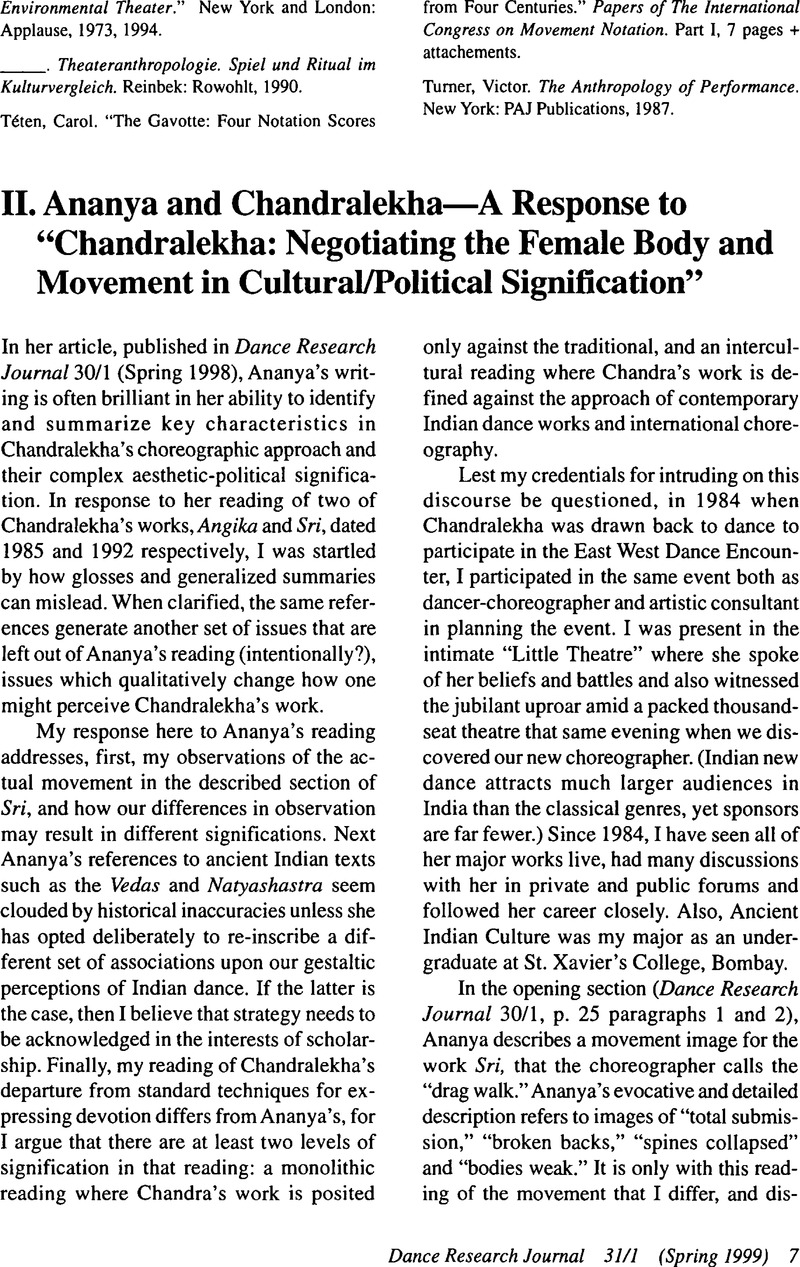Article contents
II. Ananya and Chandralekha—A Response to “Chandralekha: Negotiating the Female Body and Movement in Cultural/Political Signification”
Published online by Cambridge University Press: 22 July 2014
Abstract

- Type
- Dialogues
- Information
- Copyright
- Copyright © Congress on Research in Dance 1999
References
NOTES
1. I find it difficult to equate atma and soul, the latter being a term particular to Christianity.
2. Tarlekar, G.H., Studies in the Natyaśastra, (Delhi: Motilal Banarsidass, 1975), 16.Google Scholar
Apparao, P.S.R., On Bharata's Naatya Saastra (Hyderabad: Naatya Maala Publishers, 1967), 2.Google Scholar
Thapar, Romila, A History of India (1966; reprint, Harmondsworth, England: Penguin Books, 1978), 136.Google Scholar
3. Vatsyayan, Kapila, The Square and the Circle of Indian Arts (New Delhi, India: Roli Books International, 1983), 40, 48.Google Scholar
Vatsyayan, Kapila, “The Indian Arts, Their Ideational Background and Principles of Forms,” in Rasa, The Indian Performing Arts in the Last Twenty Five Years vol. I, ed. Kothari, Sunil (Calcutta: Anamika Kala Sangam Trust, 1995), 137–148.Google Scholar
See also Byrski, M. Christopher, Concept of Ancient Indian Theatre (Benaras: Munshiram Manoharlal, 1973.Google Scholar Byrski suggests that, while the Natyotpatti legend in the Natyashastra can be dated around 500 B.C.E., its extant literary form “undoubtedly belongs to a much later period” (Byrski 1973, 38).
4. Byrski, 1973 6–11.
5. See Coorlawala, Uttara, “Classical and Contemporary Indian Dance: Overview, Criteria and a Choreographic Analysis” (PhD. diss., New York University, 1994), 86–121.Google Scholar
6. Bharucha, Rustom, “Contextualizing Utopias: Reflections on Remapping the Present,” in Theater: Utopia and Theater vol. 26, nos. 1 and 2 (New Haven: Yale School of Drama, 1995), 38–40.Google Scholar Bharucha describes it differently, as temporal institutions (memory) mapped/projected onto spatial structures (the body).
7. Chandralekha's lecture-demonstration at the International Dance Festival and Conference in New Delhi, 1990.
8. Personal communications in New York, 1995; and Bharucha, Rustom, Chandralekha: Woman Dance Resistance (New Delhi, India: Indus, 1995), 70.Google Scholar
9. Postcolonial Indians educated in and speaking the English language cannot but be influenced by Western thought structures and knowledge systems. Chandralekha has travelled the world and avidly explores the art and ideas of the cultures she visits.
10. For more details on this reconstruction and transformation of a traditional art, see Coorlawala, Uttara, “The Birth of Bharata Natyam and the Sanskritized Body,” in Proceedings of the CORD Conference on the Body, Greensboro, North Carolina, Nov. 1996.Google Scholar Chandralekha's admiration of Rukmini Devi is documented by Bharucha in his biography, Chandralekha: Woman Dance Resistance.
11. See Rustom Bharucha, Chandralekha: Woman Dance Resistance, and various news articles in Indian papers.
- 2
- Cited by




